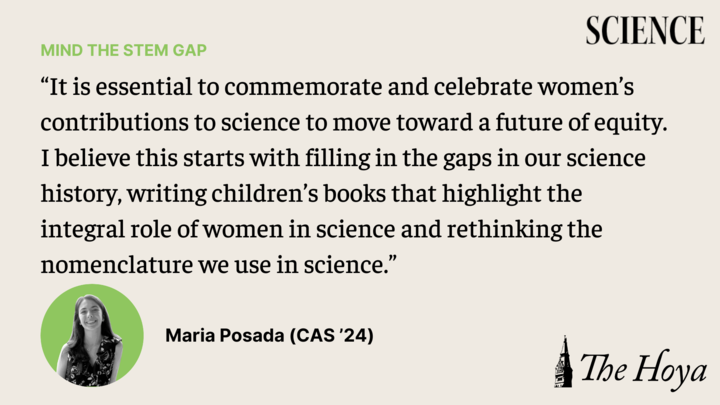In 2023, we are all aware of the systemic adversities that have faced women in scientific fields, both as researchers and as medical subjects. But while we are busy renouncing the problems women have faced, we often forget to honor and uplift what women have done for science.
It is essential to commemorate and celebrate women’s contributions to science to move toward a future of equity. I believe this starts with filling in the gaps in our science history, writing children’s books that highlight the integral role of women in science and rethinking the nomenclature we use in science.
One way to increase the representation of women in science is to fill in the gaps in science history on the internet’s largest online encyclopedia, Wikipedia. As of April 2023, only 19.51% of all biographies written in English are about women, and I would expect the percentage for women scientists to be even lower.
After recognizing this lack of documented representation in science history, Emily Temple-Wood founded the WikiProject Women Scientists working group. Inspired by her firsthand experiences with sexism in her biology degree, Temple-Wood began to create and edit biographies of women in science on Wikipedia.
This project has increased the number of articles about women scientists and improved the quality of those that already existed. Using a rating system based on factual completeness, Wikipedia editors ranked the quality of an average Wikipedia biography about a woman prior to Temple-Wood’s project as significantly worse than most other pages on Wikipedia. This “rewriting” of history by editing Wikipedia allows us to set the record straight.
A second way to ensure a more equitable future for women in science is to inspire the future generation. Instilling the important role of women in science in children by using board books to show them the amazing stories of women scientists and the value that they have added to science can inspire children to follow their dreams.
These books have the power to introduce children to the importance and impressiveness of science. By having characters in these books from all different backgrounds, every child can learn that they can be scientists.
A great example is “We Are All Scientists” written by Dr. Ellen Ochoa and illustrated by Citlali Reyes. This book, written in both English and Spanish, introduces children to science and different STEM disciplines. The book presents these ideas to kids through characters of different backgrounds and genders, allowing every child to be excited about science.
The children’s story “Counting on Katherine: How Katherine Johnson Saved Apollo 13” written by Helaine Becker and illustrated by Dow Phumiruk tells the story of Katherine Johnson. It showcases Johnson’s journey to becoming one of the first women to work in research mathematics and how she dreamed of using math to learn about the universe. Johnson plotted the flight paths of many space missions with her incredible mathematical skills and notably used her knowledge to bring Apollo 13 home after it malfunctioned in space.
Celebrating the legacy of women scientists in board books allows the stories of these women to be spoken about not only in research libraries but also in our homes. Introducing these stories to little girls shows them the amazing things they could achieve and helps all children learn that everyone belongs in science regardless of who they are.
A third way to commemorate women scientists is the renaming of processes, discoveries and places to commemorate and celebrate the women who contributed to these breakthroughs and remained widely unrecognized for years. Every day in my Georgetown classes, I discuss organisms or use principles named after men — but finding ones named after women is rare.
Some examples stare us right in the face: Georgetown’s observatory should be named after Vera Rubin, a physicist who completed her Ph.D. at Georgetown University and went on to discover evidence supporting dark matter through observations and measurements of spiral galaxies alongside Kent Ford.
The Mid-Atlantic Ridge should be named after Marie Tharp, the oceanographic cartographer who discovered this ridge and mapped the world’s underwater mountain ridges, which led to the wide acceptance of theories of plate tectonics and continental drift.
These advancements should not be limited to celebrating these women only as women scientists but should instead elevate their voices as scientists who just happen to be women. Their discoveries are amazing, not only for women but for anyone, and while it is important to recognize the difficulties that come with being a woman in STEM, their work should be celebrated equally to that of their peers.
Women do not need to be showcased in a separate forum from men, like a “women in history” column. Eventually, I hope that even this column will be obsolete as women and men become equal in science.
When people ask where the women in science are to inspire the new generations, adequate representations across media types can highlight the fact that we — women in science — are already here and always have been.









